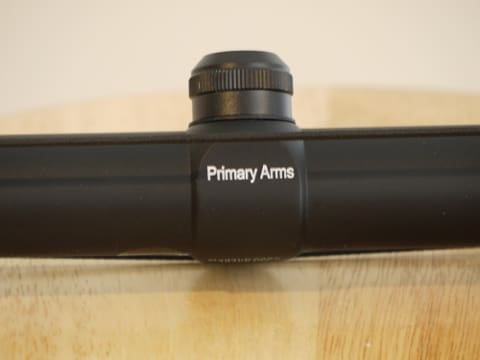 Primary Arms has made a name for themselves producing excessively cheap knockoffs of well known optics. TTAG even reviewed their Aimpoint Micro knockoff a while back (an optic I also used on my WASR’s Ultimak tube). Cheap red dots are great fun when precision accuracy isn’t necessary, but can Primary Arms’ longer range offerings prove just as good a value as their short range optics?
Primary Arms has made a name for themselves producing excessively cheap knockoffs of well known optics. TTAG even reviewed their Aimpoint Micro knockoff a while back (an optic I also used on my WASR’s Ultimak tube). Cheap red dots are great fun when precision accuracy isn’t necessary, but can Primary Arms’ longer range offerings prove just as good a value as their short range optics?
First things first (and this is more of a humorous anecdote than a criticism): Primary Arms apparently doesn’t have a Testing and Evaluation program. The normal way things get reviewed in the firearms press is that companies send out a sample, the reviewer does their magic, and then the company gets their gubbins back. With Primary Arms, as my friend pointed out, the prevailing opinion seems to be that “the thing is so cheap, just buy one.” So I did. I bought their 3-9x40mm illuminated scope.
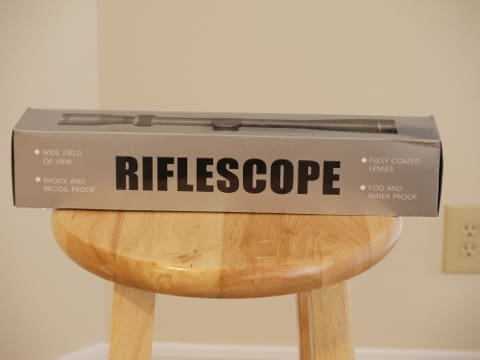 As soon as you pull the box out of the packing material, you instantly know what you purchased. “RIFLESCOPE.” Says it right there on the box, just in case you forgot and thought a lightsaber had landed on your porch. In an effort to keep the production costs low, Primary Arms appears to only uses one box for all of their scopes and just prints labels for them as needed. Which is pretty smart. If you only paid $79.99 for this kind of scope, you pretty much know what you’re getting (for reference, the Trijicon 3-9×40 Accupoint on my competition rifle seems to be going for about $590 these days). Cutting as many costs as possible to get that price point even lower makes perfect sense.
As soon as you pull the box out of the packing material, you instantly know what you purchased. “RIFLESCOPE.” Says it right there on the box, just in case you forgot and thought a lightsaber had landed on your porch. In an effort to keep the production costs low, Primary Arms appears to only uses one box for all of their scopes and just prints labels for them as needed. Which is pretty smart. If you only paid $79.99 for this kind of scope, you pretty much know what you’re getting (for reference, the Trijicon 3-9×40 Accupoint on my competition rifle seems to be going for about $590 these days). Cutting as many costs as possible to get that price point even lower makes perfect sense.
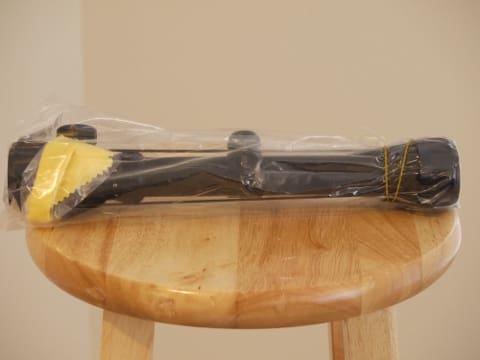
Check my first looks at the Swarovski riflescope. Notice the mountain of pillows and soft fluffy shock-absorbing materials with which Swarovski swaddled their scope. See: above. That’s the extent of the Primary Arms scope’s in-box protection. Again with the cost cutting, but this time maybe not so laudable. I’ve seen my UPS guy.
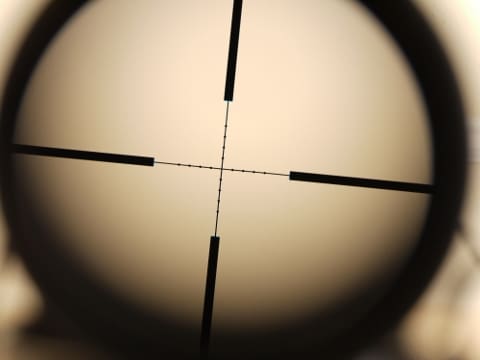 Looking through the Primary Arms 3-9×40 Illuminated Scope in my apartment everything seems pretty good. The crosshairs are a little light for my liking, but at least they’re not the massive bars that made me mark down Swarovski. The entire reticle also illuminates, turning a wonderful shade of red. Unfortunately, I couldn’t snap a good picture. Imagine the reticle above in a bright red color. The color doesn’t “bleed” outwards from the crosshairs; it stays the same size whether the light is on or off.
Looking through the Primary Arms 3-9×40 Illuminated Scope in my apartment everything seems pretty good. The crosshairs are a little light for my liking, but at least they’re not the massive bars that made me mark down Swarovski. The entire reticle also illuminates, turning a wonderful shade of red. Unfortunately, I couldn’t snap a good picture. Imagine the reticle above in a bright red color. The color doesn’t “bleed” outwards from the crosshairs; it stays the same size whether the light is on or off.
The scope also has some markings on the reticle, but Primary Arms says that they’re not calibrated to anything that they know of (not mils and not MoA).
The Primary Arms 3-9×40 Illuminated Scope’s magnification is nice and works great. But as soon as you start to turn the knob you notice another annoyance. The reticle is in the second focal plane of the scope; as you magnify the target the reticle remains the same size. Put another way, the distance between the dots changes based on the magnification settings.
Working the Primary Arms 3-9×40 Illuminated Scope,the proportions change wildly. The space between the dots could be 1 inch at one magnification and 1 foot at another. I’m sure you could work out the different distances and magnifications, but that adds a level of complexity to the situation that I don’t want, need or enjoy.
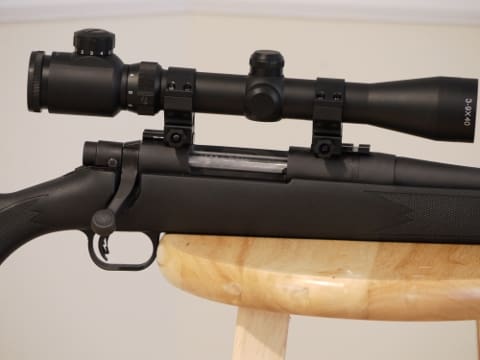 At the range a further annoyance pops up: the Primary Arms 3-9×40 Illuminated Scope’s parallax isn’t adjustable. (Click here for more about parallax and how it sucks.) WIth a non-adjustable parallax, either the corsshairs or the target are constantly out of focus. And so the dots are completely useless (because you just can’t see them).
At the range a further annoyance pops up: the Primary Arms 3-9×40 Illuminated Scope’s parallax isn’t adjustable. (Click here for more about parallax and how it sucks.) WIth a non-adjustable parallax, either the corsshairs or the target are constantly out of focus. And so the dots are completely useless (because you just can’t see them).
All that said, the Primary Arms 3-9×40 Illuminated Scope still works. Through 40 rounds of 7.62×51 NATO ammunition it held zero like a champ, never waivering from where I set it. The illumination, which I first almost dismissed as a gimmick, actually comes in useful (the parallax is so bad that the reticle is almost invisible). And best of all . . . it’s cheap!
The Primary Arms 3-9×40 Illuminated Scope is a cheap scope for cheap bastards. Despite all my techno-kvetching it functions just fine. For the price I can live with the imperfections, and I’m pretty sure that was PA’s goal all along.
[UPDATE] It turns out that it didn’t take long for this scope to get beaten to death on top of a .308 Winchester rifle. Parts started flying off after abut 200-300 rounds. If you get this scope consider the caliber for which you intend to use it, and I personally would not recommend anything stouter than a 5.56x45mm NATO rifle.
Specifications: Primary Arms 3-9×40 Illuminated Scope
Weight: 15 oz.
Length: 12.5″
Adjustments: 1/4 MoA
Eye Relief: 4″
Tube: 30mm
MSRP: $79.99
Ratings (out of five)
Optical Clarity * * *
There’s some definite issues with refraction, especially around the edges, but the center of the scope seems pretty clear.
Feel & Function * * * * *
Everything feels and functions as it should. The zoom zooms, the clicks click, the zero is held, and the illumination illuminates.
Overall Quality *
Come on, you knew what you were getting before you even clicked “buy.” This isn’t something to be cherished and treasured from generation to generation, this is a temporary filler for that bolt action you have in the closet until you can save up for a good scope. [UPDATE] In light of its recent demise I decided to drop this rating down one star.
Overall Rating * *
It works. It does what it was designed to do and not a thing more. It’s a respectable scope for a respectable price, and something that will remain on my rifle. [UPDATE] Since the demise of this scope I have dropped the rating one star, and this scope now needs to be replaced. You get what you pay for, I guess.

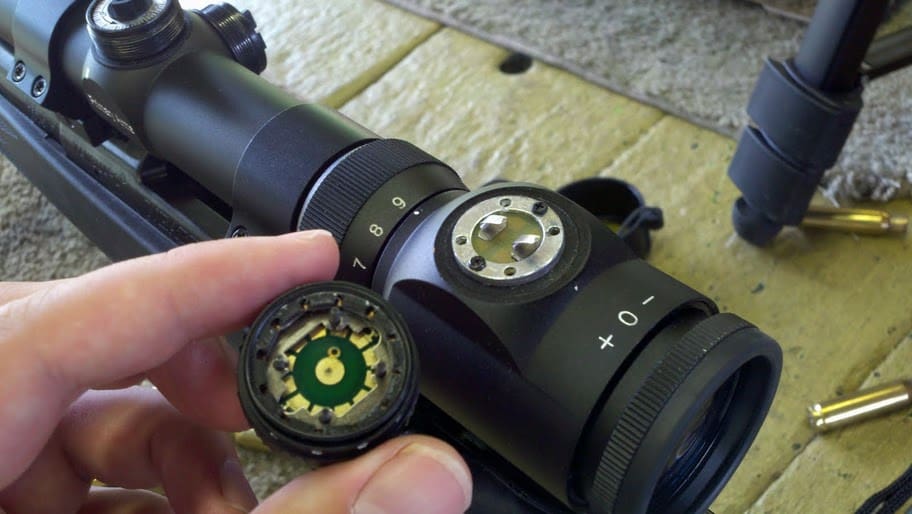



Primary Arms sells a rough-edged little gem in their Micro Red Dots, and I have to say I’m a little disappointed that they couldn’t exceed our expectations at least a little bit with this scope also. At such a low price, those expectations are pretty easy to exceed.
The similarly-priced Tasco is also plagued by the Magical Magnifying Mil-dots, but it does have adjustable parallax.
All second focal plane scopes vary scale by magnification, no matter how expensive. That’s what a lot of consumers want. If you don’t want that, buy a first focal plane scope. Don’t blame the manufacturer because you wanted one thing and bought another. But even on second focal plane scopes, there is one magnification at which the scale is correct. This magnification is usually indicated in the manual, or marked on the dial.
Which magnification this is would be useful information in a review. Hint, hint.
+1
Normally, the second focal plane scopes I see don’t have known distance markings on the reticle. Which makes sense. I would have been perfectly happy with a plain crosshairs, but Primary Arms only offers their long range scopes with these mildots. Because of the mildots I was expecting a first focal plane scope, but I was disappointed (PA’s site doesn’t mention first/second focal plane status of their optics). I’m not complaining (in fact a three star scope for $80 is money well spent in my opinion, I really liked this scope), I’m simply reporting so that others don’t expect this to be a first focal plane scope from Primary Arms.
The information on what these marks are at a given magnification were nowhere to be found. Not on the scope, not in the less than helpful user’s manual, and not on the site. I tried contacting Primary Arms, but I didn’t get a reply.
Primary Arms has a pretty significant presence in the industry section at Ar15.com.
http://www.ar15.com/forums/forum.html?b=2&f=325
The majority of deer hunters out there will sight it in at 100 yds, and then shoot deer all season long at somewhere near that range. Especially in states where you can (legally) use feeders. For those guys (of whom I used to be one), it will work just fine. And not a one of them will care about the mil-dots.
Comments are closed.